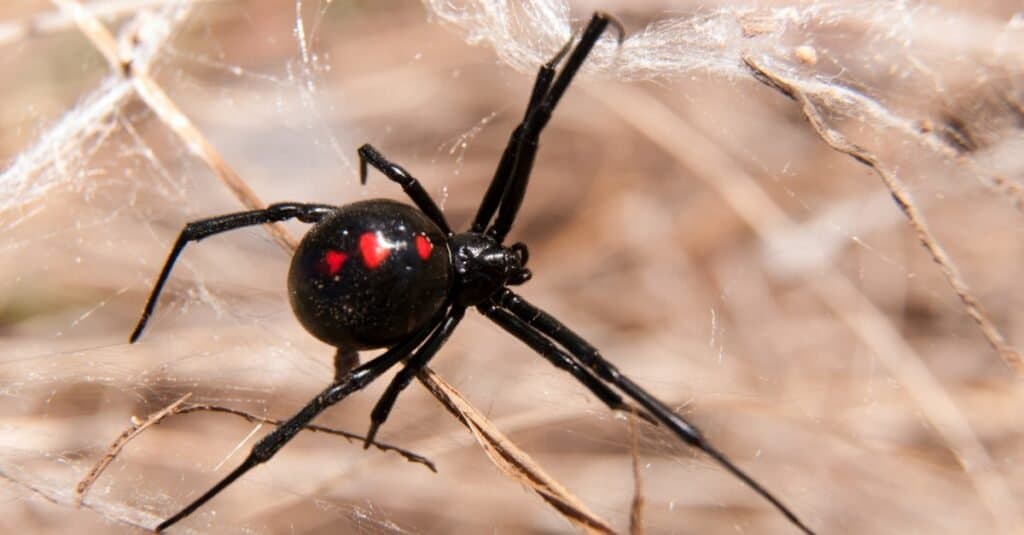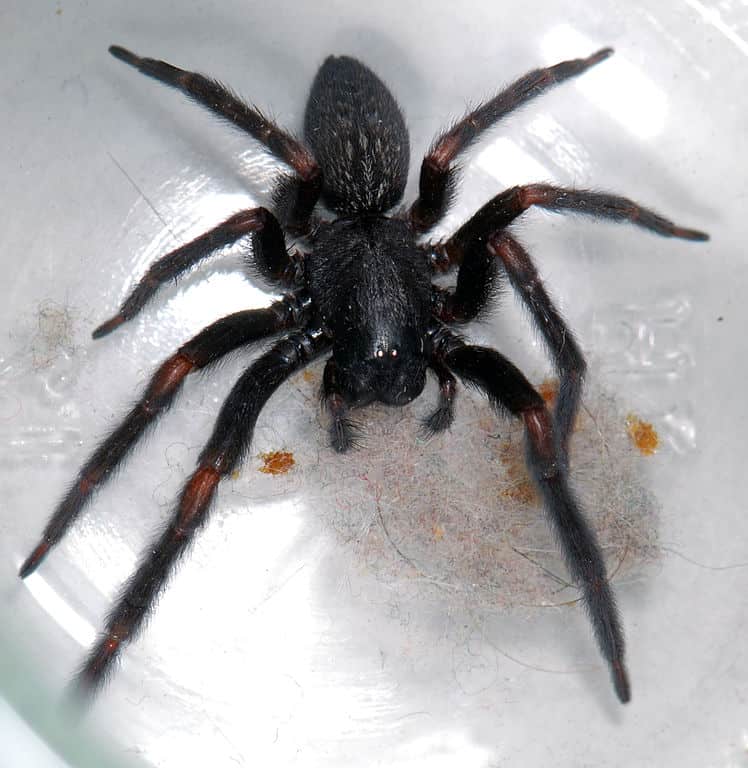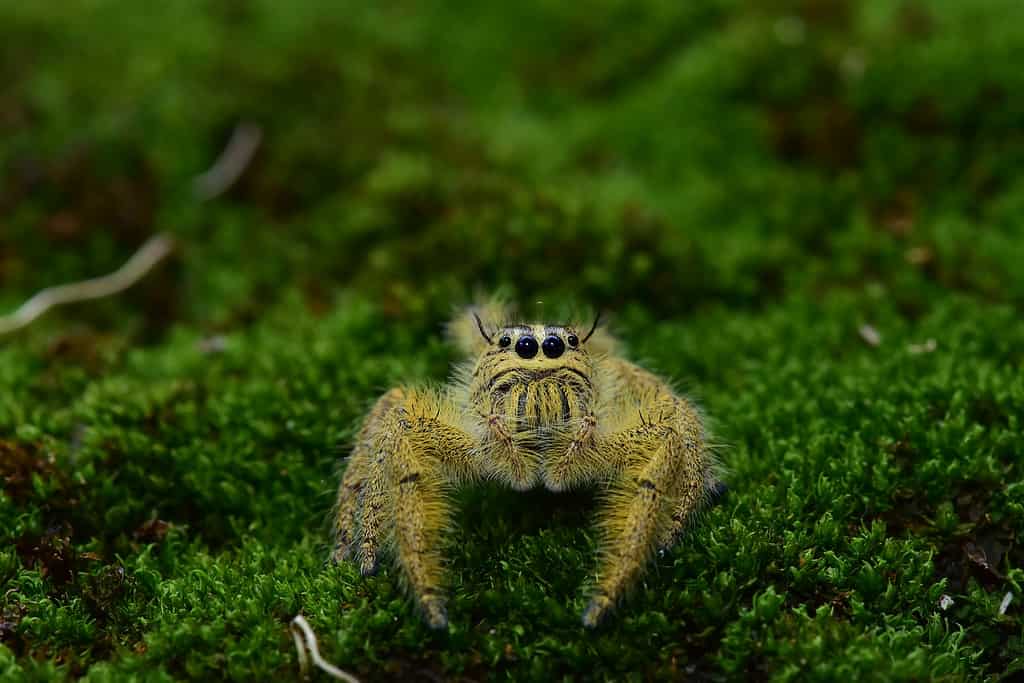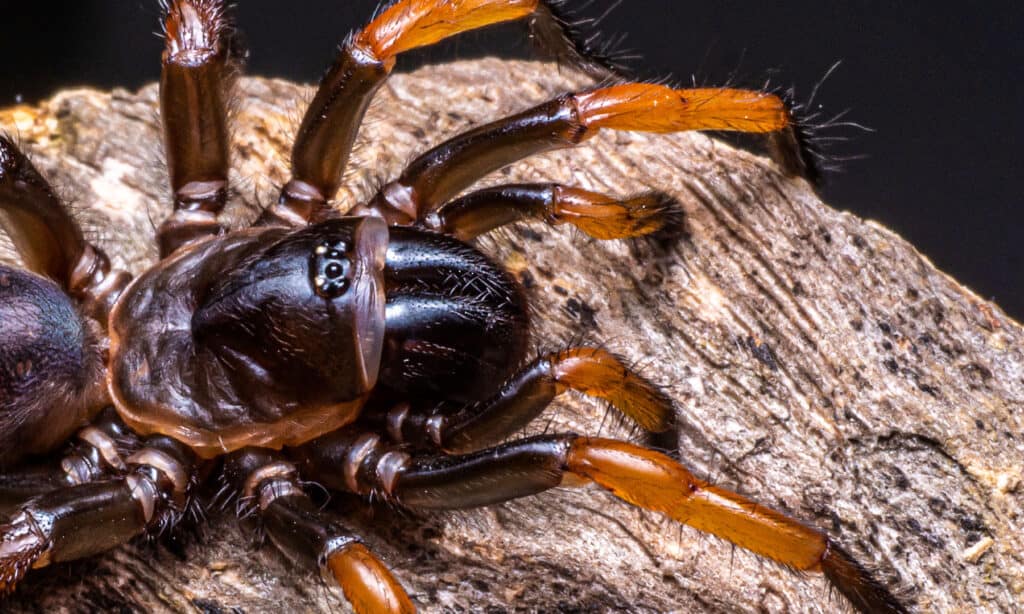You might not think of the Sooner State as a hub for creepy crawlers, but there are actually quite a few different species of black spiders in Oklahoma. Let’s take a look at some of the most common black spiders in Oklahoma; some of which are venomous!
1. Black Widow
Classification: Latrodectus spp.
Theridiidae, or “cobweb weaver,” is the family of venomous spiders that includes the black widow. They are a source of fascination and concern due to their famed reputation for potentially harmful bites. Black widows are known to live in a range of environments, including forests, fields, gardens, and man-made structures, and they can be found in Oklahoma.
Black widows can be easily recognized by concentrating mostly on the female spider’s appearance. Adult female black widows have a characteristic shiny black body that is typically between half an inch and one inch long. The red or orange hourglass-shaped pattern on the underside of their spherical abdomen is their most distinguishing characteristic. The most noticeable black widow marking is a red hourglass shape on its abdomen. However, other species have other markings, such as a pair of red spots or a string of red dots.
Male black widows have lighter coloring and fewer obvious markings than females. They are also smaller and less venomous. Black widow juveniles can exhibit a variety of patterns and markings, usually mimicking adult males.
Black Widow Safety Precautions
Exercise caution when working in uninhabited places, woodpiles, or cluttered areas where black widows may form their erratic cobweb-like webs to prevent potential interactions with them. Black widows seldom bite people and only do so in self-defense or when they perceive a threat. Their bites also seldom kill humans. However, you must proceed with caution and refrain from touching or frightening them.
Contacting a skilled entomologist or local pest control professionals is advised if you suspect the presence of black widows or are worried about a possible infestation. These professionals can help you identify the insects accurately and advise you on the best management strategies.

Numerous types and species of black widow (pictured) can be found throughout the state of Oklahoma.
©Sari ONeal/Shutterstock.com
2. Black and Yellow Garden Spider
Classification: Argiope aurantia
The stunning Black and Yellow Garden spider is a common spider in fields and gardens across Oklahoma. It draws people’s attention with its distinctive coloring and outstanding web-building abilities.
It is not difficult to recognize the Black and Yellow Garden spider. Males are smaller and less noticeable whereas females are bigger, measuring around an inch in length. On their bodies, stripes of black and yellow are alternated. Females have a huge, noticeable, and symmetrical hourglass- or zigzag-shaped yellow or orange marking on their abdomen. A distinctive pattern sometimes referred to as the “stabilimentum,” is typically located in the middle of their complex circular webs.
These garden spiders are expert weavers, creating enormous, spherical, vertical orb webs. Their finely woven webs have a distinctive zigzag pattern in the middle. It’s unclear what this stabilimentum does, although it could draw prey or keep larger animals from unintentionally harming the web.
Oklahoma gardens, meadows, and fields are among the sunny, vegetated locations that Black and Yellow Garden spiders like. With a peak in activity in late summer, they are usually active from late spring through early fall.
It should be noted that Black and Yellow Garden spiders are not thought to be harmful to people. They seldom bite unless provoked or threatened and are typically passive and non-aggressive. These spiders are advantageous to the ecology since they are essential in regulating insect populations.
If you come across a Black and Yellow Garden spider, it’s a wonderful chance to watch its complex web-building skills and be amazed by its distinctive coloring. To minimize unintentional bites, it is important to avoid touching or upsetting these spiders as with any other animal.

While the Black and Yellow Garden spider (pictured) may have a startling appearance, it is generally harmless to humans.
©Ron Rowan Photography/Shutterstock.com
3. Hacklemesh Weaver
Classification: Callobius spp.
Oklahoma is home to the common arachnid species known as the Hacklemesh weaver spider. They are members of the Amaurobiidae family and are distinguished by both their unusual looks and intriguing activities. The term “Hacklemesh weaver” comes from the herringbone pattern on the abdomens of these mostly nocturnal predators.
It is usually easy to recognize Hacklemesh weaver spiders. Adult females measure between a quarter to a half-inch in length, while males are a little bit smaller. They have elongated bodies. Typically dark brown or black in hue, these spiders have a distinctive herringbone or chevron pattern on their abdomens. Their legs have bands of lighter and darker hues, which adds to their distinctive look.
In Oklahoma, Hacklemesh weaver spiders are often found in a range of settings, such as woods, grasslands, and gardens. They build their erratic and tangled webs close to the ground, frequently in leaf litter, behind logs, or in low vegetation. These webs act as a trap for insects that live on the ground, which the spiders quickly catch and eat.
Despite having venom, Hacklemesh weaver spiders are not thought to pose a threat to human health. They are typically non-aggressive and, when startled, prefer to flee rather than bite. To minimize unintentional bites, it is advisable to keep a safe distance from any spiders you meet and show caution while approaching them.

The Hacklemesh weaver (pictured) is a harmless spider that is known for building erratic and odd-looking webs throughout Oklahoma.
©Eric Isselee/Shutterstock.com
4. Black House Spider
Classification: Badumna insignis
The black house spider is a typical species of spider found in Oklahoma and other places. These spiders, as their name implies, are frequently observed in and around buildings built by humans that include homes, barns, sheds, and other structures.
The black house spider may be recognized rather easily. They have a body that ranges from dark brown to black and often looks shiny or lustrous. Males are shorter than females, who can grow to lengths of up to half an inch. The head and thorax, also known as the cephalothorax when combined, are generally bigger and more robust than the abdomen. Their legs are thin and rather lengthy.
Black house spiders are adept web makers, creating erratic and disorganized webs in nooks, cracks, and other untouched regions of structures. These webs might be followed by a funnel-shaped retreat where the spider hides and are usually of irregular shape.
Black house spiders are also found in urban and suburban regions of Oklahoma, where they can find sufficient cover and food. They have been observed living in a wide range of human constructions, particularly those with cluttered or uninhabited regions.
It’s important to note that black house spiders typically avoid humans and will usually flee rather than bite when startled. Nevertheless, care should be used while interacting with any spider.

The black house spider (pictured) are known for living in human homes or constructions like barns and garages.
©Peter Halasz (User:Pengo) / CC BY-SA 2.5 – License
5. Jumping Spiders
Classification: Salticidae family
The very diverse group of spiders known as black jumping spiders are renowned for their exceptional vision, agility, and distinctive hunting strategies. Numerous species of black jumping spiders inhabit a range of environments in Oklahoma, including grasslands, woodlands, gardens, and even cities.
Black jumping spiders can vary in size, coloration, and behavior. This makes it difficult to identify them without precise species information. But they usually have certain things in common. Black jumping spiders often have stocky compact bodies and relatively big eyes, which contribute to their outstanding visual acuity. They often have thick, powerful legs that allow for outstanding leaping ability.
Despite having a black body as a whole, certain species may have extra patterns or iridescent colors. These marks, which might be white, metallic green, red, or orange, are frequently used to identify species. However, their leaping style and the presence of black coloring might help separate them from other spider families.
Black jumping spiders are energetic predators who spot their prey with their acute vision. With amazing accuracy, they hunt and attack their prey, often leaping great distances. Their main sources of food are tiny arthropods and insects like flies and mosquitoes. In Oklahoma, it’s not unusual to run upon black jumping spiders, especially in open areas with lots of vegetation.

There are many different species and varieties of jumping spiders (pictured) found throughout Oklahoma and much of the United States.
©Fredyngahu/Shutterstock.com
6. Black Purseweb Spider
Classification: Sphodros genus
Black purseweb spiders are members of the Atypidae family and are distinguished by their distinctive digging habits and distinctive web patterns. The Sphodros genus of black purseweb spiders, as well as other species, are found in Oklahoma.
Without a closer look, identifying black purseweb spiders might be difficult. These spiders are usually black or dark brown in color and have stocky bodies. They have sturdy legs that are ideal for digging and building burrows. Females generally measure between a half to one inch longer than males.
The term “black purseweb” refers to the unusual appearance of the spiders’ webs, which resemble a silken tube or purse. They dig their burrows in the earth, frequently next to or behind logs, boulders, or leaf litter. A silken web “door” or “trapdoor” that the spider may utilize to ambush passing victims is placed over the tunnel entrance.
Black purseweb spiders are often observed in grasslands, forests, and other environments with sufficient soil for burrowing in Oklahoma. They spend the majority of the night hunting for insects and other tiny arthropods by trapping them in their burrows.
Despite having venom, black purseweb spiders are not thought to be medically dangerous to people. In general, they are not aggressive. If startled, they would rather return inside their burrows than bite. To minimize unintentional bites, it’s best to keep your distance and stay away from them when around them. Finding a black purseweb spider in Oklahoma offers a rare chance to observe its interesting burrowing habits.
7. Black Ground Spiders
Classification: Gnaphosidae family
Black ground spiders are a diversified group of spiders recognized for their skill at hunting and preference for the ground. Black ground spiders are members of the Gnaphosidae family. These ground spiders come in a variety of species, and they may be found in Oklahoma’s grasslands, woodlands, gardens, and even urban settings.
Without knowing the species, it can be difficult to distinguish between different black ground spiders because of their wide range in size and appearance. But they frequently have certain things in common. Black ground spiders often have flat, compact bodies that enable them to move readily through cracks and small areas. They usually have dark brown or black coloring, which helps them blend in with the surroundings as they live underground.
Black ground spiders are skilled hunters who catch prey with their amazing speed and agility. Instead of creating sophisticated webs, they actively hunt for food on the ground. They frequently ambush their prey with lightning-fast attacks. Insects and other tiny invertebrates make up the majority of their diet.
Black ground spider sightings are common in Oklahoma, particularly in places with vegetation or leaf litter. They are often not harmful to people and when confronted, are more likely to flee than to bite. When touching or disturbing any spider, caution should still be used. Black ground spiders have a crucial role in maintaining healthy ecosystems, which may be better understood by seeing them in their natural environment.
8. Black Trapdoor Spider
Classification: Ummidia spp.
The interesting arachnids known as black trapdoor spiders are members of the Ummidia genus. They are distinguished by their extraordinary trapdoor constructions. Oklahoma is home to a number of black trapdoor spider species, including Ummidia spp.
Without a thorough study or information relevant to a particular species, identifying black trapdoor spiders might be difficult. They do, however, typically have certain things in common. These spiders have sturdy bodies and black or dark brown coloring to help them blend in near the entrances of their burrows. They have powerful legs that are designed for digging and building their burrows.
It is well known that black trapdoor spiders have excellent digging prowess. They dig tunnels in the earth, usually close to vegetation or in uninhabited places. A “trapdoor” with hinges composed of earth and silk surrounds the burrow entrance. The spider can hide itself behind this door while waiting for prey to pass by, thus using these trapdoors as a form of protection and ambush.
Black trapdoor spiders are usually seen in Oklahoma’s forests, grasslands, and gardens, among other environments. They frequently inhabit regions with an appropriate substrate for burrowing and prefer well-drained soil.
The fact that black trapdoor spiders often avoid humans and prefer to hide in their burrows when threatened should not be overlooked. Although its venom is not thought to be harmful to people, care should be taken to avoid touching or upsetting them.

Black trapdoor spiders (pictured) are known for building trapdoors into their burrows with earth and silk in order to hide and trap prey.
©nokkaew/Shutterstock.com
Are All Black Spiders in Oklahoma Dangerous?
No, not every black spider poses a threat to humans. A spider’s color, including whether or not it is black, does not always indicate how dangerous it is to people. There are several harmless black spider species that don’t threaten people that we’ve covered in this guide.
For instance, the great majority of black spiders you would come across, such as black jumping spiders and black ground spiders, are often harmless and lack any detectable venom. When approached or agitated, these spiders tend to flee rather than bite.
How cool are these black spiders in Oklahoma? With the right know-how on how to identify them, spider aficionados can find these spiders and enjoy their presence without putting their safety (or the spider’s safety) at risk.
The photo featured at the top of this post is © iStock.com/NajaShots
Thank you for reading! Have some feedback for us? Contact the AZ Animals editorial team.






